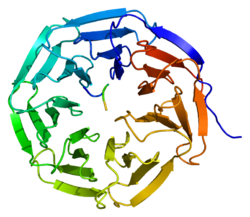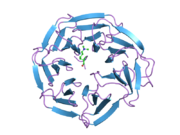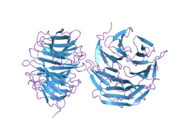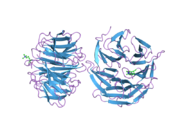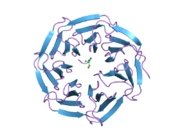WDR5
Appearance
WD repeat-containing protein 5 is a protein that in humans is encoded by the WDR5 gene.[5][6]
Interactions
WDR5 has been shown to interact with Host cell factor C1[7][8] and MLL.[7] It also interacts with the long non-coding RNA HOTTIP.[9] WDR5 is a key determinant for MYC recruitment to chromatin[10]
References
- ^ a b c GRCh38: Ensembl release 89: ENSG00000196363 – Ensembl, May 2017
- ^ a b c GRCm38: Ensembl release 89: ENSMUSG00000026917 – Ensembl, May 2017
- ^ "Human PubMed Reference:". National Center for Biotechnology Information, U.S. National Library of Medicine.
- ^ "Mouse PubMed Reference:". National Center for Biotechnology Information, U.S. National Library of Medicine.
- ^ Gori F, Divieti P, Demay MB (Dec 2001). "Cloning and characterization of a novel WD-40 repeat protein that dramatically accelerates osteoblastic differentiation". J Biol Chem. 276 (49): 46515–22. doi:10.1074/jbc.M105757200. PMID 11551928.
{{cite journal}}: CS1 maint: unflagged free DOI (link) - ^ "Entrez Gene: WDR5 WD repeat domain 5".
- ^ a b Yokoyama, Akihiko; Wang Zhong; Wysocka Joanna; Sanyal Mrinmoy; Aufiero Deborah J; Kitabayashi Issay; Herr Winship; Cleary Michael L (Jul 2004). "Leukemia proto-oncoprotein MLL forms a SET1-like histone methyltransferase complex with menin to regulate Hox gene expression". Mol. Cell. Biol. 24 (13). United States: 5639–49. doi:10.1128/MCB.24.13.5639-5649.2004. ISSN 0270-7306. PMC 480881. PMID 15199122.
{{cite journal}}: Cite has empty unknown parameters:|laydate=,|laysource=, and|laysummary=(help) - ^ Wysocka, Joanna; Myers Michael P; Laherty Carol D; Eisenman Robert N; Herr Winship (Apr 2003). "Human Sin3 deacetylase and trithorax-related Set1/Ash2 histone H3-K4 methyltransferase are tethered together selectively by the cell-proliferation factor HCF-1". Genes Dev. 17 (7). United States: 896–911. doi:10.1101/gad.252103. ISSN 0890-9369. PMC 196026. PMID 12670868.
{{cite journal}}: Cite has empty unknown parameters:|laydate=,|laysource=, and|laysummary=(help) - ^ Wang KC, Yang YW, Liu B, Sanyal A, Corces-Zimmerman R, Chen Y, et al. (2011). "A long noncoding RNA maintains active chromatin to coordinate homeotic gene expression". Nature. 472 (7341): 120–4. Bibcode:2011Natur.472..120W. doi:10.1038/nature09819. PMC 3670758. PMID 21423168.
- ^ Thomas, L. R.; Tansey, W. P. (2015). "Interaction with WDR5 Promotes Target Gene Recognition and Tumorigenesis by MYC". Molecular Cell. 58 (3): 1–13. doi:10.1016/j.molcel.2015.02.028. PMC 4427524. PMID 25818646.
Further reading

